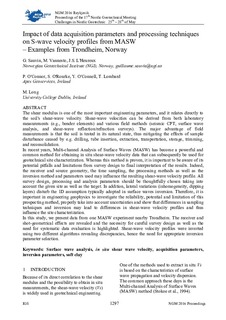| dc.description.abstract | The shear modulus is one of the most important engineering parameters, and it relates directly to the soil's shear-wave velocity. Shear-wave velocities can be derived from both laboratory measurements (e.g., bender elements) and various field methods (seismic CPT, surface wave analysis, and shear-wave reflection/refraction surveys). The major advantage of field measurements is that the soil is tested in its natural state, thus mitigating the effects of sample disturbance caused by e.g. drilling, tube insertion, extraction, transportation, storage, trimming, and reconsolidation. In recent years, Multi-channel Analysis of Surface Waves (MASW) has become a powerful and common method for obtaining in situ shear-wave velocity data that can subsequently be used for geotechnical site characterization. Whereas this method is proven, it is important to be aware of its potential pitfalls and limitations from survey design to final interpretation of the results. Indeed, the receiver and source geometry, the time sampling, the processing methods as well as the inversion method and parameters used may influence the resulting shear-wave velocity profile. All survey design, processing and analysis parameters should be thoughtfully chosen taking into account the given site as well as the target. In addition, lateral variations (inhomogeneity, dipping layers) disturb the 1D assumption typically adopted in surface waves inversion. Therefore, it is important in engineering geophysics to investigate the reliability, potential and limitation of this prospecting method, properly take into account uncertainties and show that differences in sampling techniques and inversion may lead to differences in shear-wave velocity profiles and thus influence the site characterization. In this study, we present data from one MASW experiment nearby Trondheim. The receiver and shot-geometrical effects are revealed and the necessity for careful survey design as well as the need for systematic data evaluation is highlighted. Shear-wave velocity profiles were inverted using two different algorithms revealing discrepancies, hence the need for appropriate inversion parameter selection. | |
